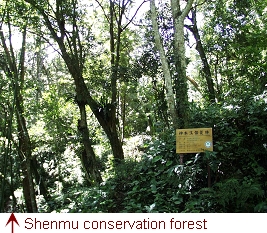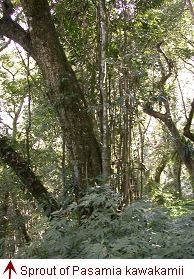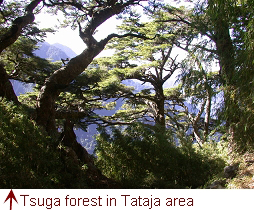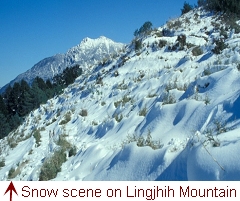The Experimental Forest, with an area of 32.781 ha, is located at the north of tropic of cancer, with anfractuous terrain and a wide elevational gradient of 3,700 m that hosts abundant biological resources and climatic belts of sub-tropical, warm-temperate, cool-temperate, cold-temperate, and frigid zones. Each climatic zone has special forest types that make The Experimental Forest worthy of being called as the best site in Southeast Asia for conducting forest research, teaching and field practice. The natural vegetation types within the Experimental Forest are described as follows:
 I. Ficus-Machilus Zone:
I. Ficus-Machilus Zone:
This vegetation type is located below 500 m in elevation, i.e. sub-tropical forest. For the early contact with human beings, bamboo plantations, orchards or other farming lands occupy this zone for economic purposes. At present only few patches dominated by Dendrocalamus latiflorus are conserved.
II. Machilus-Castanopsis Zone:
This vegetation zone, mainly dominated by species of Lauraceae and Fagaceae, ranges from 500 m to 1,500 m in elevation. Currently intact primary forests of this vegetation zone are located on Fenghuang Mountain in Xitou and the 29, 30 forest compartments in Shalixian valley.
III. Quercus Zone:
This vegetation zone is located above the Machilus-Castanopsis Zone and ranges from 1,500 m to 2,500 m in elevation. With increasing altitude, plants of Lauraceae are gradually replaced by plants of Fagaceae. The forests are dominated by broad-leaved trees with scattering conifers of Chamaecyparis formosensis, Taiwania cryptomerioides and Pinus morrisonicola.. Primary forests in this vegetation zone mainly locate at the 22, 24, 25, 27 and 30 forest compartments.
 IV. Tsuga-Picea Zone:
IV. Tsuga-Picea Zone:
It is mainly located at the saddle of Tataja area from about 2,300 m to 3,000 m in elevation, where Tsuga chinesis and Picea morisonicola dominate, scattering with conifers of Pinus armandii var. masteriana, Pinus taiwanensis, Chamaecyparis formosensis and Chamaecyparis obtuse. Additionally, some broad- leaved trees such as Trochodendron aralioides, Eurya glaberrima, Photinia niitakayamensis, Quercus spinosa can be found. Dense shrubs of Yushania niitakayamensis and Miscanthus transmorrisonensis overwhelm the forest floor.
V. Abies Zone: 
It is located at Yushan area with altitude more than 3,000 m, where is mainly composed by pure stands of Abies kawakamii and shrubs of Ribes formosanum.
VI. Alpine Vegetation Zone:
This vegetation zone ranges above 3600 m, mainly on the peaks of Yushan Mountain. It is mainly covered by Juniperus squamata var. morrisonicola, which are creep shrubs at the windward zone while arbor at the leeward ridge or cirque valley, accompanied by Berberis morri- sonensis, Juniperus formosana and Rhododendron pseudo- chrysanthum etc..